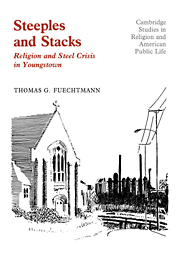Book contents
- Frontmatter
- Contents
- List of Tables and Figures
- Acknowledgments
- Introduction
- I Steeltown
- II The Industry
- III Shutdown
- IV Coping with Crisis: Community Response to the Shutdown
- V Religion and Urban Economic Crisis
- VI Launching a Movement
- VII The Plan
- VIII Negotiations
- IX Ending, Learning, Beginning Anew
- X Epilogue
- Notes
- References
- Index
II - The Industry
Published online by Cambridge University Press: 29 March 2010
- Frontmatter
- Contents
- List of Tables and Figures
- Acknowledgments
- Introduction
- I Steeltown
- II The Industry
- III Shutdown
- IV Coping with Crisis: Community Response to the Shutdown
- V Religion and Urban Economic Crisis
- VI Launching a Movement
- VII The Plan
- VIII Negotiations
- IX Ending, Learning, Beginning Anew
- X Epilogue
- Notes
- References
- Index
Summary
The United States was the dominant steelmaker for the world in the period from 1900 through World War II – the boom period for Youngstown. Immediately after the war, the United States was responsible for more than half the total world steel production. But as steel industries in Japan and Europe were rebuilt and expanded, that position naturally changed. Although it was to be expected that the American share of total world production would drop, it was not expected that the United States would become a net steel importer. By the 1970s, America was the one major industrial economy that did not meet its own steel requirements. The relative decline in American steel between the late 1940s and the late 1970s is an integral part of the Youngstown story.
Crisis for American Steel
The year 1959 marks a date when things changed for American steel. During an industry-wide strike lasting 116 days, steel consumers relied on the newly built steel mills of Japan and Europe to maintain their inventories. For the first time since the turn of the century, the United States imported more steel than it exported. The situation was not deemed critical at the time, but it developed that steel contract negotiations every three years brought a significant increase in steel imports, principally as hedge buying against a strike. Partly to stem this trend the United Steelworkers adopted an Experimental Negotiating Agreement with the industry in 1973, ensuring that contract negotiations would be settled without a strike. Nevertheless, imports remained at a fairly high level and even increased.
- Type
- Chapter
- Information
- Steeples and StacksReligion and Steel Crisis in Youngstown, Ohio, pp. 34 - 53Publisher: Cambridge University PressPrint publication year: 1989

